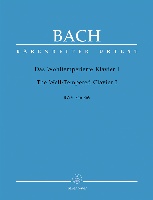Wo Gott der Herr nicht bei uns hält (Where God the
Lord stands with us not), BWV 178, is a church cantata
by Johann Sebastian Bach. He composed it in Leipzig for
the eighth Sunday after Trinity and first performed it
on 30 July 1724. It is a chorale cantata from his
second annual cycle, based on the hymn Wo Gott der Herr
nicht bei uns hält (1524) by Justus Jonas, a
paraphrase of Psalm 124.
Bach composed the cantata in his second year in Leipzig
for the Eighth Sunday after Trinity. Th...(+)
Wo Gott der Herr nicht bei uns hält (Where God the
Lord stands with us not), BWV 178, is a church cantata
by Johann Sebastian Bach. He composed it in Leipzig for
the eighth Sunday after Trinity and first performed it
on 30 July 1724. It is a chorale cantata from his
second annual cycle, based on the hymn Wo Gott der Herr
nicht bei uns hält (1524) by Justus Jonas, a
paraphrase of Psalm 124.
Bach composed the cantata in his second year in Leipzig
for the Eighth Sunday after Trinity. The prescribed
readings for the Sunday are from the Epistle to the
Romans, "For as many as are led by the Spirit of God,
they are the sons of God" (Romans 8:12--17), and from
the Gospel of Matthew, the warning of false prophets
from the Sermon on the Mount (Matthew 7:15--23). The
cantata text is based on the hymn "Wo Gott der Herr
nicht bei uns hält", published in 1524 by the Lutheran
reformer Justus Jonas as a paraphrase of Psalm 124. The
theme of the psalm, the need of help against raging
enemies, corresponds to the Gospel. Compared to Bach's
other chorale cantatas of the period, the unknown poet
kept much of the original text, six of the eight
stanzas, expanding two of them by recitative, to
connect even closer to the Gospel. He paraphrased only
stanzas 3 and 6 to an aria each. In the last aria, in a
statement of opposition to rationalism—the "weasel
words of rationalists, who would bring down the whole
Lutheran theological edifice" in the words of John
Eliot Gardiner—the poet expands the words of the
reformers' hymn, "Vernunft kann das nicht fassen"
(reason cannot grasp it), appealing to reason,
described as unstable and frenzied, to be silent.
Bach first performed the cantata on 30 July 1724, as
the eighth chorale cantata of his second annual
cycle.
Johann Nikolaus Forkel borrowed the manuscripts of
Bach's chorale cantatas from Bach's son Friedemann and
copied two of the cantatas, Es ist das Heil uns kommen
her, BWV 9, and this cantata.
As in most of Bach's chorale cantatas, the opening
chorus is a chorale fantasia. The chorale tune was
published in 1529 by an anonymous author in Wittenberg.
The soprano sings this chorale melody line by line,
doubled by the horn, as a cantus firmus to the
independent concerto of the orchestra. The strings play
"agitated dotted rhythms", the oboes "agitated
semiquaver cascades" throughout the movement, supplying
a sense of unity. The lower voices sing partly in
homophony, partly in independent movement similar to
the instruments. Bach uses the contrast to illustrate
the text in the first lines, with no regard to its
negation. "Wo Gott der Herr nicht bei uns hält" is set
in homophony and the last word "hält" (literally:
"holds") is held as a long note, whereas in "wenn unsre
Feinde toben" the raging of the enemies is shown in
dotted rhythm and fast runs. When the bar form's
Stollen is repeated in the following lines, Bach
repeats the music also, although it doesn't reflect the
text.
In the following chorale and recitative, Bach
distinguishes the chorale lines from the secco
recitative by a continuo line on a repeated motif that
is derived from the beginning of the respective melody
line, termed "in rhythmically compressed form ... four
times as fast".
The first aria shows the image of "wild sea surf" in
undulating movements in the voice, in the obbligato
part of the violins in unison, and in the continuo. The
bass voice has to sing challenging coloraturas on the
words "Meereswellen" and especially "zerscheitern" (be
wrecked).
The center of the cantata is an unchanged stanza of the
chorale, the alto's unadorned melody accompanied by the
oboes d'amore and the continuo as equal partners.
In movement 5, Bach differentiates chorale and
recitative differently from movement 2. The chorale
lines are four-part settings, the recitatives are given
to individual different singers in the sequence bass,
tenor, alto, bass. The continuo unifies the movement by
a constant independent regular motion in motifs based
on triads.
In the last aria Bach invents a setting for strings
that illustrates the instability of "frenzied reason"
in syncopated rhythm, interrupted by chords on the
repeated appeal "schweig!" (be silent). The drama of
the aria rests only at the end of the middle section,
when the words "so werden sie mit Trost erquicket"
(they will be revived with solace) are given by a
fermata and the marking adagio. The cantata is closed
by two stanzas of the chorale in a four-part
setting.
Although this cantata was originally scored for three
vocal soloists—alto, tenor and bass—a four-part
choir, horn, two oboes, two oboes d'amore, two violins,
viola and basso continuo, I created this arrangement
for Concert (Pedal) Harp.





 Faire un don
Faire un don